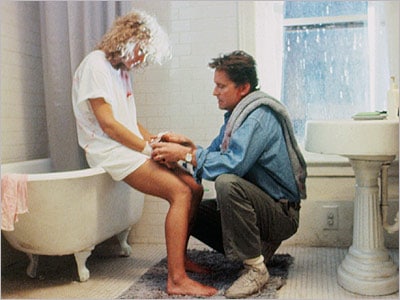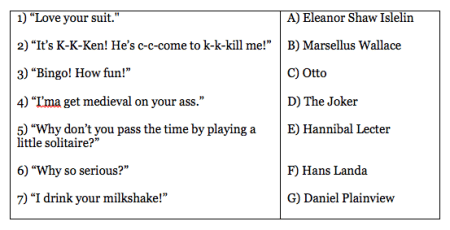Called “Hollywood’s hardest working filmmaker” by talk show host Casey Ryan, guest blogger Anne Lower has written and directed for the stage and screen; her plays have won awards in Los Angeles, Seattle, New York, Oklahoma City, and Denver. She has had screenplays reach finalist in the PAGE awards and the Sundance Table read. Anne’s web series, They Live Among Us, debuted last fall. She hopes the next installation of TLAU will be launched soon. She and her partner Geoff Reeves’ pilot, Interglobal Trading Fund, was greenlit and shot this fall, with a distribution deal in place through Red 5 Studios. Anne and Geoff are shopping an adventure/reality show, packaging a one-hour cable pilot, and have other various things in development. Anne blogs about life in Hollywood at Princess Scribe, recently named “Screenwriting Web Site of the Week” by SCRIPT Magazine. Her feature, EDEN, is slated for production in summer 2013. In her spare time, when she is not working out, playing with fast cars, or cooking up a storm, Anne can be found sleeping. Sometimes.
I’ve written before about the Save the Cat! moment: how it has been well-used, and how, it is oft misunderstood and abused… and how it can be a powerful addition to your screenwriter’s toolbox.

Halloween approaches, and naturally, my thoughts turn to things that go bump in the night. In keeping with the spirit of All Hallow’s Eve, I thought I’d explore another use for the Save the Cat! moment… and how Save the Cat! can save the villain.
“Preposterous!” you cry. “The Save the Cat! moment is one of unity between character and audience! It invites us into the world of the protagonist… it sets up a relationship in which we can relate to, identify with, or understand him or her. How on earth can this principle work for the Bad Guys???”
How, indeed. And yet, I believe that it does, for the Save the Cat! moment is like any other storytelling principle: once mastered, it becomes malleable. Of course, you must learn the form in its virgin incarnation, but once you have been able to organically understand and apply the technique, the storytelling world is your oyster to dine on.
This is not to say that the principle can be universally applied. Not all antagonists/villains have Save the Cat! moments. Characters such as the Terminator, Voldemort, Bruce the Shark, and Cruella de Ville are much more at home in their badness. Their characters are clearly defined; there are no shades of grey in their world. They are single-minded and determined in their wrath.
However, there are other characters, who, on occasion, startle us during their dark journeys. These are the Save the Cat! moments. They are there, I believe, for a variety of reasons. To lull us. To present us with moral dilemmas… and sometimes, to simply scare the hell out of us.
Let’s take a look, shall we? And perhaps you’ll come up with a few of your favorites along the way. Spoiler alerts ahead!
A Tool of Empathy
Empathy is a great emotion to generate when dealing with a villain, for it immediately connects the audience with him or her. It humanizes them; it’s an “I’ve been there before” moment. It’s the cinematic equivalent of Medea, in that great moment of despair, before she succumbs to her rage. We’re there with her… until she crosses the threshold into darkness.
Think of The Caine Mutiny during Bligh’s cross-examination on the stand. The silver balls in his hand that he rolls around and around. Bligh’s steadfast determination to discover who stole the strawberries. This is a commander in distress – but there is no S.O.S. sent out. Bogart is in his acting prime; we watch as Bligh’s tenuous grasp on reality is gleefully chipped away by his accusers… and for this, our heart breaks for him, in spite of his dastardly deeds.

There’s been a gender war in play ever since Fatal Attraction burst onto the scene. Men loathe the character of Alex Forrest, the blonde vixen (masterfully played by Glenn Close), while women understand her, and often cheer for her – up to a point. We’ve all been there, girls. We meet a guy. He’s totally into us. A drink or two, sparks fly, and we wake up the next morning thinking WTF. He seems like a nice guy. One who genuinely cares… that is, until his wife comes back home.
I was watching the movie with a friend recently, and afterwards, we discovered that initially it was Alex we really cared for. She had the likeability factor; her only sin was to fall for a guy who was not being totally up front. She had us in her corner… until things began to fall apart. Setting up a meeting with is wife? Creepy. Acid on the car? The East German judge gave her a 9.5 for drama, but, girl, really. And then, the rabbit… and we switched our allegiances as quickly as a political candidate.
The Likeability Factor
Let’s admit it. We love the bad guys. Sometimes, they are just plain fun to watch. Great writers know this – and they give these characters unforgettable dialog. That’s their Save the Cat! moment: wit.
We relish their wordplay, and as we do, we are lulled into forgetting just how dangerous these men and women can be.
Let’s play a game! Can you match the correct line with the correct character?
[See answers at the end of the blog.]

We love it when Lecter one-ups Doctor Chilton; we giggle with fearful glee as we watch him chase down dinner. Hans Landa claps his hands with childlike enthusiasm when he tops his strudel with sweet whipped cream. There’s something golden about a villain who truly loves his or her job. Their joie de vivre is infectious… until that moment in which the mask drops, and the Gorgon is revealed.
Go Ahead. Scare the Hell Out of Me.
“Some men just want to watch the world burn.” ~ The Dark Knight Rises
You know the type. They love their job. They are good at it. They do it because they think they are right. And usually, they are pretty damn good at what they do.
Anton Chigurh (Javier Bardem) from No Country for Old Men is one of the greatest archetypes of modern-day storytelling. He’s an angel of death, plodding relentlessly through the desert Southwest, holding a coin that determines life or death for those he encounters. The simple man in the gas station eludes death’s cold grasp by merely calling heads as the coin falls. Lady luck is not so kind to others.
Ed Norton’s portrayal of the altar boy Aaron in Primal Fear offers one of the most chilling forays into the mind of a killer… and none of it crystallizes until the final few lines. Initially, he falls under category 1: mentally ill, impoverished, a simple, sweet victim of abuse – or so we think. Like all great villains, Aaron has a mask – and he is very skilled at using it. At the end of the film, we realize that he murders because he enjoys every bloody moment of the act.
…and then we have Amon Goeth, the death camp commando with delusions of grandeur. He’s a terrifying presence; I’d rather do battle with Orks than with Amon. What makes him so frightening? He, like Nurse Ratchett, truly believes in his job. He thinks himself noble for what he does; he sees himself as a god, pausing occasionally to bestow mercy – or not – on those around him. He is mercurial; like Caligula, he is in a seat of power and grows drunk on it. He might not be a vampire, or a vengeful wraith, but his soul is seated in the depths of hell. If he were to glance your way, your flesh would turn to goose-pimples, and you would need to look away. His acts of mercy are STC! moments – but not to endear us to him, but to drive home the message of just how deadly this man is.
So, les chats, there are a few more examples of Save the Cat! at play. Think on it – for your antagonist to be truly effective, you must spend as much, if not more, time on him/her as you do your protagonist. Your antagonist must be a worthy opponent; your audience must fear that s/he will win. Pull out all your tools – and all stops. Build them well – and let them play.
Just make certain you keep them under lock and key when you have retired in the evening. You wouldn’t want them running out on the streets late at night, would you?
answers: 1 – E, 2 – C, 3 – F, 4 – B, 5 – A , 6 – D, 7 – G
BJ Markel
15 Comments
Leave a Reply Cancel reply
You must be logged in to post a comment.










I think it’s important with a villain to figure out his or her backstory and develop a childhood wound that is the origin for the descent into the dark side–however that is portrayed. A hint of that wound somewhere in the story makes for a richer, more compelling character.
Love this! I am in a rewrite of a script right now and am in need of giving some more substance to my protagonist. This will help!
Annie,
You blurr the benchmark of goodness felt by the audience for the Hero who saves the helpless kitty up the tree. Are you sure you’ve been Baptised in the Blake faith?
And I’m not sure about your AMEN corner either.
Captain
Hi Debra!
I think it depends on the character. A backstory to Chigurh would lessen the primal impact that he has; he’s more a character out of ancient mythology than a post-Freud/Jungian character.
The same could possibly be argued for the Joker. He does tell several stories about what happened to cause his wounds, two stories, I believe… but the third choice is far more terrifying. Perhaps he just likes to look that way. Or, as Alfred was quoted, “Some men just want to watch the world burn.”
Primal Fear did not go into the character of Aaron, but the book did, and, if I recall, Aaron was deemed born bad. Yes, he grew up in poverty, but his family loved him… for awhile. What distanced their love was their growing fear of him.
I think Harris’ third part to the Hannibal trilogy was a failure b/c it attempted to apply the Jungian/Freud explanation to what was most likely, simply one borne of hell. The attempt to humanize Lecter just didn’t work.
But yes, for some characters, of course that can be a model, although I find the childhood abuse rationalization to be far, far overused in storytelling. Like any tool, it needs to be used only when absolutely necessary – and with precision. ;)
Best,
anne
Thank you, Michael! Still loving your blog from last week!
Captain, you can – and will – still feel goodness/kindness/understanding for the hero.
But as all tools, this is one that can be used in very subtle ways – and to achieve many things.
Not only was I baptized, but trained by the Grand Poo-ba himself. I am pretty sure that Blake would have loved this blog.
best,
anne
Annie,
I am sure Blake would have liked the blog and the two before it because they are absolutely excellent.
It’s strange…some villains we empathize with because of their humanity (Hannibal Lecter, quite charming); some villains we are just totally frightened of (Anton Chigurh.) My hubby used to have a crush on Penelope Cruz, but now he’s had to drop her because he fears that Javier Bardem will come after him, tee hee.
Michelle: Isn’t it interesting how we sometimes yearn to relate to the bad guys? Does that make us bad girls?
Captain: You know, all of these thoughts/suggestions/reflections are really just instruments to add to your toolkit. You, as the master builder, will know which tools will serve you best during construction, yes>
Debra: I may have misunderstood your post, for, on reflection, it sounds as if you are referring to the prep/outline process as opposed to the construction of the script. If so, apologies. Yes, you can never have too much backstory! No writing is ever wasted writing… I do think that sometimes we, as modern humans, try to rationalize evil too much. So, I do respect and like a tale where told in which evil exists because… evil exists, not because of past trauma, although there is a place for that, as well. A funny aside, in theatre, when someone has a long “this happened to me when I was little and now I’m scarred for life” monologue, we always referred to it as the “Dead Cat” monologue. How fittingly appropriate! ;)
~ anne
Hi Anne. Thought provoking blog. It brings to mind something Robert Johnson (Jungian analyst and author) said about “the shadow”, and how there was “gold in it” — and by that he meant characteristics like humor, inventiveness, sexual energy, spontaneity and confidence. Thinking of those attributes in STC terms, most if not all of them are possessed by the best villains, especially the trickster villains who are working a deception, many of which you named above. Hitchcock famously said he was more interested in his villains than his leading men, and it shows; his entire filmography explores the shadow side with a giddy (fiendish?) relish. The above-listed attributes are certainly likeable, and always compelling. The most important one, I think, is confidence, and that usually comes with status or power. Villains usually have both. The Terminator, Voldemort, Chigurh, Hans Landa, Daniel Plainview and Goeth all have the confidence of power. So does Hannibal Lector, and he’s got charm, to boot, just like most Hitchcock villains. Cruella has all the above plus an insanely theatrical grandiosity which is comic (likeable). The Joker is the darkest, most disturbing version of that. The Amon Goeth of anarchy. I’d say Gollum and Heath Ledger’s Joker characterization are remarkably similar, by turns comic and sinister, childlike and silly followed by unleashed malevolent Id. They’re two of the best film villains of all time. We want to hate our villains, but want to love them, too — so we can love to hate them! The best recipe of all. I’d like to make one more point, and that is, giving the villain a strict STC moment in the classic Snyderian sense — that is, giving them a sympathetic action — always makes them more complex and humanizes them, which I believe increases audience interest. In a way, Hannibal Lector’s entire relationship with a Clarice Starling is one long drawn-out STC moment — he spares her. And he might have decided to do that the moment he met her, or the moment he made his initial assessment of her drive, ambition, integrity, and damaged pysche. All of these things made her interesting, and worthy of sparing. Gollum does some nice things for Frodo, too, at least in his Smeagol form. But we know to be wary because Gollum can come roaring back in the blink of an eye. This creates tension, one of the single most important elements of drama. After being conditioned to think of The Terminator as the ultimate unstoppable enemy of man, it was a master stroke by Cameron’s part to “flip” him and make him the good guy in T2. That was an STC character choice. But he was still a Terminator, so you never knew how that would express itself, and this dichotomy sustained tension, as well. So your points are right on the mark, as usual. I would sum it up by adding that it’s always a good idea for us to approach fashioning the villain with as much F&G (Fun & Games!) in mind as possible. Then we’re likely to craft a likeable, empathetic, complex, humanized, and entertaining foil for the Hero. We just can’t forget to do the same for them!
Tom
A stronger villain forces the hero to step up his game if he wants to win. So when I need to make my hero stronger, more active, and more interesting, I go work on his villain – it works every time! :D
Rachel! Yes! Give your guy/gal a mighty foe to go to battle with!
Tom, what a great and thoughtful comment… and yes, you can use a traditional STC! moment. That’s what I refer to as the Likeability factor… something that humanizes them, creates empathy, and lulls us into feeling safe…
…and then Lecter picks up the knife and says “Ready when you are, Sergeant Pembry…” and once again we see the Gorgon’s face. Brilliant!
The answer to 3 is F
Thanks, Rokman!